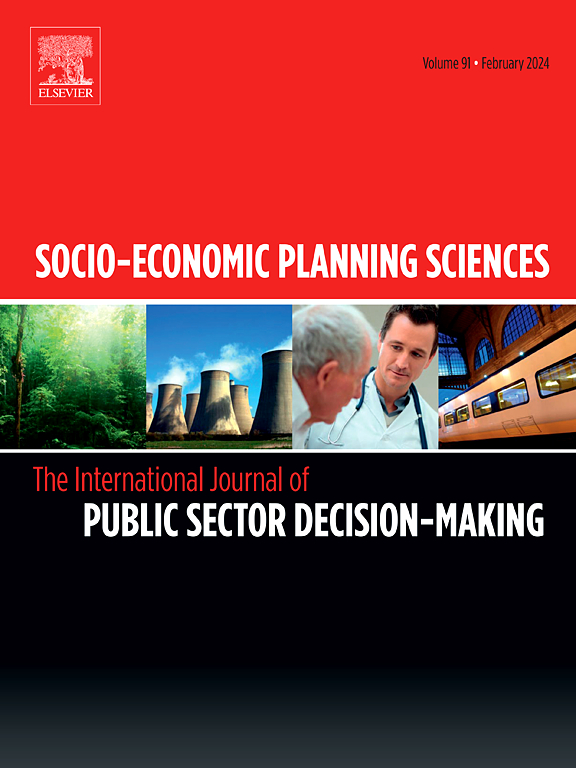A multi-objective supply chain model for reducing carbon emissions and food losses in a multi-period mixed product environment
IF 5.4
2区 经济学
Q1 ECONOMICS
引用次数: 0
Abstract
Environmental sustainability is increasingly crucial in supply chain management due to global warming. This presents challenges in optimizing supply chains for profitability while addressing carbon emissions and food loss. Cold chain technologies, while reducing food loss, often increase carbon emissions due to energy use. Strategies like market differentiation and reprocessing can mitigate food losses. This study develops a multi-period supply chain model that accounts for product quality differentiation, specifically focusing on mixed products comprising both processed and fresh food items. The model employs multi-objective mixed-integer linear programming to simultaneously optimize total profit and carbon dioxide emissions. It incorporates the aspect of diminishing food quality and addresses practical supply chain issues like batch production, inventory management, and remanufacturing. The study shows that two multi-objective planning approaches, LP-metrics and the ε-constraint method, can successfully reduce carbon emissions, albeit with a slight decline in profits. The ε-constraint method proves to be the most effective, achieving a 27.1 % emissions reduction with a 20.16 % profit decrease. In contrast, LP-metrics achieve a 20.32 % reduction in emissions with a smaller profit decrease of 12.34 %. Additionally, the research examines how carbon pricing policies affect supply chain planning. The results show that setting the carbon tax at 100 NTD leads to a modest decrease in carbon emissions but comes with a significant reduction in profit. Evaluating the outcomes of two assessment methods suggests that the recommended carbon pricing falls between 150 and 225 NTD. However, it may still be necessary to implement other complementary measures.
在多周期混合产品环境中减少碳排放和粮食损失的多目标供应链模型
由于全球变暖,环境可持续性在供应链管理中变得越来越重要。这对优化供应链以提高盈利能力,同时解决碳排放和粮食损失提出了挑战。冷链技术在减少粮食损失的同时,往往由于能源使用而增加碳排放。市场差异化和再加工等策略可以减轻粮食损失。本研究开发了一个多周期供应链模型,该模型考虑了产品质量差异,特别关注包括加工食品和新鲜食品在内的混合产品。该模型采用多目标混合整数线性规划,同时优化总利润和二氧化碳排放量。它结合了食品质量下降的方面,并解决了批量生产、库存管理和再制造等实际供应链问题。研究表明,两种多目标规划方法,即LP-metrics和ε-constraint方法,可以成功地减少碳排放,尽管利润略有下降。结果表明,ε约束方法最有效,减排27.1%,利润降低20.16%。相比之下,lp指标实现了20.32%的减排,利润减少了12.34%。此外,研究还探讨了碳定价政策如何影响供应链规划。结果表明,设定100新台币的碳税会导致碳排放的适度减少,但会导致利润的显著减少。评估两种评估方法的结果表明,建议的碳定价介于150至225新台币之间。但是,可能仍有必要实施其他补充措施。
本文章由计算机程序翻译,如有差异,请以英文原文为准。
求助全文
约1分钟内获得全文
求助全文
来源期刊

Socio-economic Planning Sciences
OPERATIONS RESEARCH & MANAGEMENT SCIENCE-
CiteScore
9.40
自引率
13.10%
发文量
294
审稿时长
58 days
期刊介绍:
Studies directed toward the more effective utilization of existing resources, e.g. mathematical programming models of health care delivery systems with relevance to more effective program design; systems analysis of fire outbreaks and its relevance to the location of fire stations; statistical analysis of the efficiency of a developing country economy or industry.
Studies relating to the interaction of various segments of society and technology, e.g. the effects of government health policies on the utilization and design of hospital facilities; the relationship between housing density and the demands on public transportation or other service facilities: patterns and implications of urban development and air or water pollution.
Studies devoted to the anticipations of and response to future needs for social, health and other human services, e.g. the relationship between industrial growth and the development of educational resources in affected areas; investigation of future demands for material and child health resources in a developing country; design of effective recycling in an urban setting.
 求助内容:
求助内容: 应助结果提醒方式:
应助结果提醒方式:


